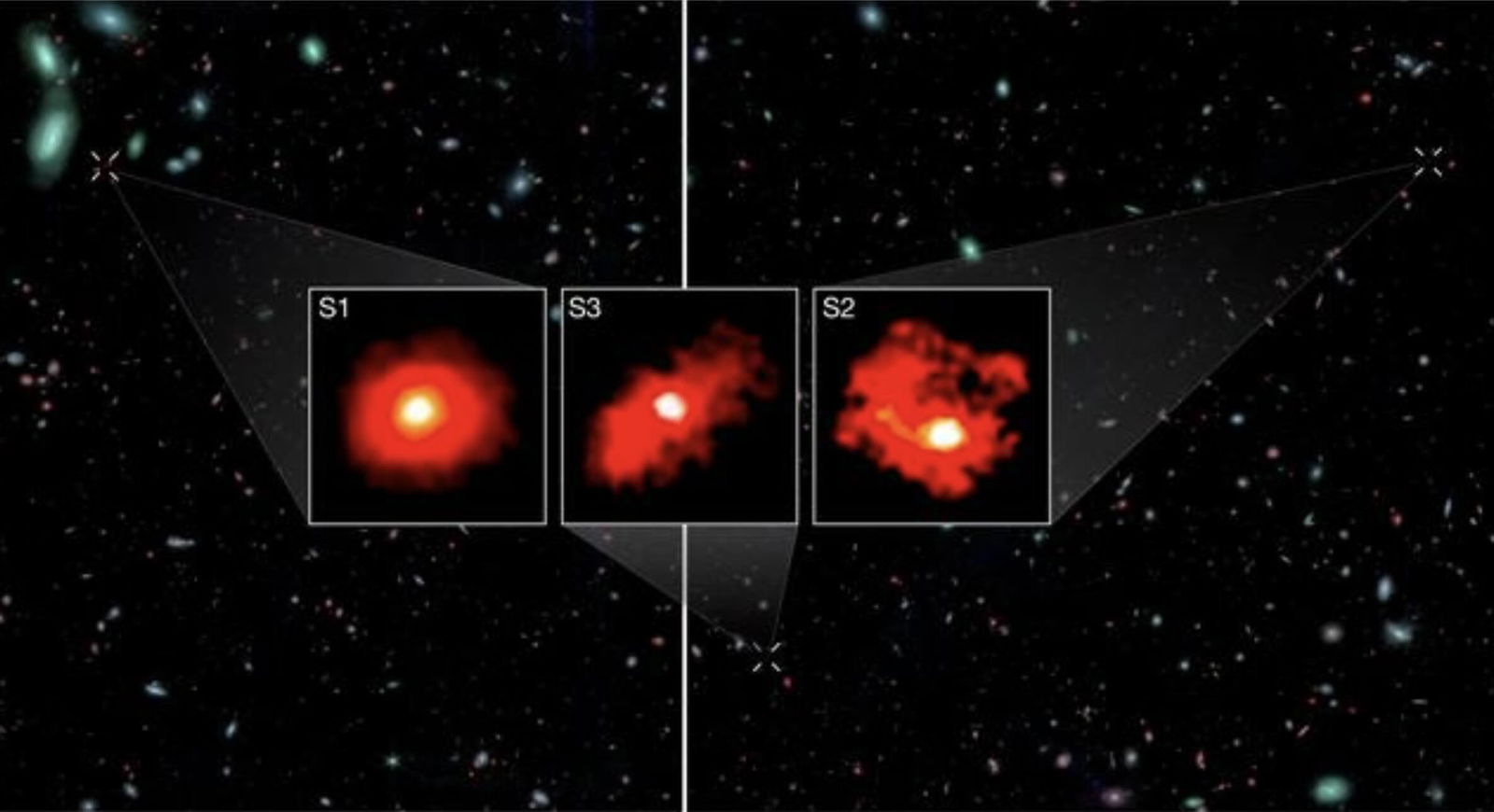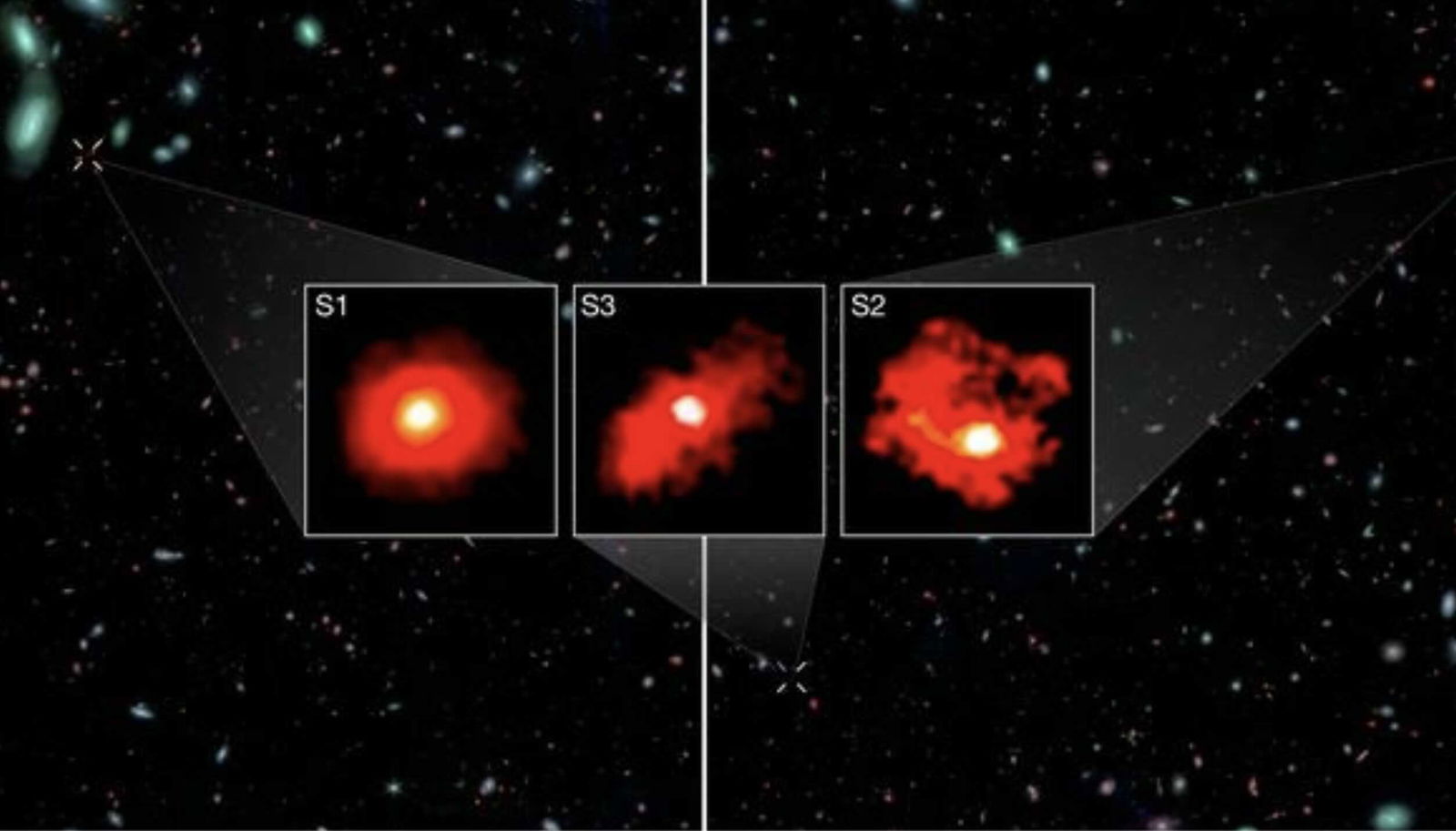Three newly identified “red monsters” discovered by the James Webb Space Telescope (JWST) are offering new insights into the state of the early universe, and further complicating our accepted ideas about how galaxies are formed.
The latest findings involve three ultra-massive galaxies, each comparable in size to the Milky Way, which had already reached their monstrous size within the first billion years the universe existed after the Big Bang. The discovery, made by an international team led by Stijn Wuyts from the University of Bath in the UK, lend further weight to the idea that our current models regarding the formation of galaxies are still far from complete.
It’s All About Emission Lines
The discovery was a result of the new JWST First Reionization Epoch Spectroscopically Complete Observation (FRESCO) program, which is collecting information about the distances and stellar masses of emission-line galaxies by collecting data from deep near-infrared spectroscopic observations. Such galaxies produce specific lines in the spectra of the light they generate, each of which stand out at specific wavelengths.
Based on their observations, the team was able to calculate the distances of these galaxies and the wavelengths of their emission lines in their sample, which revealed detailed information about the number of stars each galaxy contained.


“Red Monsters” at the Edge of the Universe
From these measurements, the team says three particularly monstrous galaxies began to stand out among the others they had analyzed.
Something the research team found particularly unusual involved how various widely accepted processes in galactic evolution are expected to place constraints on stellar processes, like how gases they contain are used in the formation of stars over time.
“Many processes in galaxy evolution have a tendency to introduce a rate-limiting step in how efficiently gas can convert into stars,” said Professor Wuyts, the co-author of a new study detailing his team’s findings.
“[Y]et somehow these Red Monsters appear to have swiftly evaded most of these hurdles,” he added.
According to Wuyts, discovering three “monster” galaxies like this was puzzling for the team, given that until recently, galactic formation was believed to occur within what astrophysicists liken to “halos” of dark matter that catch cosmic gases within the influence of their gravity, allowing around one fifth of this material to accumulate into celestial structures over time.
Challenging Views on the Formation of Galaxies
Contrary to this accepted view on galaxy formation, the discovery of these “red monsters,” originating from a period in the universe astronomers hadn’t expected challenges these traditional views, and seems to point to unknown processes that allowed them to grow much faster than expected.
As with many recent past discoveries, the remarkable imagery made possible by the JWST is what allowed Wuyts and the team to peer to the furthest reaches of the known universe and observe these massive galaxies. In addition to their incredible distance from Earth, each of the galaxies is also mostly obscured by dust that shields them from view when observed at normal wavelengths of light.
With help from JWST’s NIRCam, these three enormous red galaxies were revealed in unprecedented detail during the FRESCO survey, showcasing a series of celestial bodies that appear to be forming stars close to twice as well as other smaller galaxies from around the same period.
Dubbed the three Red Monsters, the name given to these galaxies has less to do with their size than the large quantities of dust encircling them, which contributes to their distinctive reddish appearance in the new Webb imagery.
“The massive properties of these Red Monsters were hardly determined before JWST, as they are optically invisible due to dust attenuation,” said Dr David Elbaz, a collaborator on the new research.
New Challenges for Old Ideas on Cosmology
Although nothing about the team’s observations necessarily conflicts with the standard model, Wuyts and the team nonetheless acknowledge that the JWST imagery presents certain challenges for astronomers.
“Already in its first few years of operation, JWST has thrown us a couple of curveballs,” Wuyts concedes. “In more ways than one, [JWST] has shown us that some galaxies mature rapidly during the first chapters of cosmic history.”
Fundamentally, the team’s observations of these cosmic monsters at the edge of our universe are helping to upend our currently accepted models of galactic evolution.
“Our findings are reshaping our understanding of galaxy formation in the early Universe,” said Dr Mengyuan Xiao, a postdoctoral researcher at UNIGE and the lead author of the team’s new study.
“These results indicate that galaxies in the early Universe could form stars with unexpected efficiency,” Xiao added.
“As we study these galaxies in more depth, they will offer new insights into the conditions that shaped the Universe’s earliest epochs.”
“The Red Monsters are just the beginning of a new era in our exploration of the early Universe,” Xiao said.
The team’s new paper, “Accelerated formation of ultra-massive galaxies in the first billion years,” appeared in Nature on November 13, 2024.
Micah Hanks is the Editor-in-Chief and Co-Founder of The Debrief. He can be reached by email at micah@thedebrief.org. Follow his work at micahhanks.com and on X: @MicahHanks.

